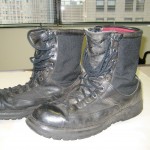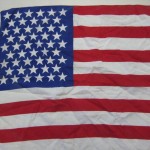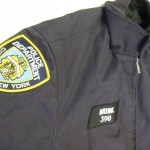“A Living History: The Stories Behind 9/11 Artifacts” is a three-part series written by oral historian Jenny Pachucki of the 9/11 Memorial Museum and edited by Meghan Walsh, communications associate for the 9/11 Memorial. "Three Ensembles: The Seasons of Ground Zero" is part 3 of 3 in the series. (All photos by 9/11 Memorial staff)
NYPD officer David Brink recently arrived at the 9/11 Memorial Museum's office with a large suitcase. From it, he pulled out what he called his "three ensembles," all of which he donated to the museum's collection along with other storytelling artifacts. Each of the three ensembles were articles of clothing that correspond to certain times Brink worked at ground zero for nine months during the recovery period.
A Clear, Blue Sky on 9/11
 On September 11, 2001, Brink dressed in light clothing perfect for a beautiful fall day. Brink recalled donning his standard issued emergency services unit response uniform, consisting of sturdy black boots, gun belt, ropes and repelling gear. The uniform was completed with a Scott air pack. While his response uniform was light, his gear weighed about 70 pounds. “It is mind-blowing to think about the men and women who attempted to climb the stairs of a 110-story building on a hot day, carrying 70 pounds of gear,” said Oral Historian for the 9/11 Memorial Jenny Pachucki. “It makes sense that they would want their clothing to be a light as possible.”
On September 11, 2001, Brink dressed in light clothing perfect for a beautiful fall day. Brink recalled donning his standard issued emergency services unit response uniform, consisting of sturdy black boots, gun belt, ropes and repelling gear. The uniform was completed with a Scott air pack. While his response uniform was light, his gear weighed about 70 pounds. “It is mind-blowing to think about the men and women who attempted to climb the stairs of a 110-story building on a hot day, carrying 70 pounds of gear,” said Oral Historian for the 9/11 Memorial Jenny Pachucki. “It makes sense that they would want their clothing to be a light as possible.”
Among the Protective Gear, a U.S. Flag
 Laden with protective gear, Brink sought inspiration in a piece of clothing that wasn't standard issued. It was the U.S. flag scarf he “grabbed from the hospitality tent.” He wore it around his neck as a reminder of the swell of patriotism and support he felt while working “on the inside.” A uniform supply stored donated battled tested pants, jackets and first-responder patches to Brink and other workers. He was grateful for the clothing donations because he was able to replace, without any cost to him, NYPD uniforms damage at the site. NYPD officers are required to pay for their own uniforms.
Laden with protective gear, Brink sought inspiration in a piece of clothing that wasn't standard issued. It was the U.S. flag scarf he “grabbed from the hospitality tent.” He wore it around his neck as a reminder of the swell of patriotism and support he felt while working “on the inside.” A uniform supply stored donated battled tested pants, jackets and first-responder patches to Brink and other workers. He was grateful for the clothing donations because he was able to replace, without any cost to him, NYPD uniforms damage at the site. NYPD officers are required to pay for their own uniforms.
Recovery Work Continues into the Bitter Cold
 As fall turned to winter, Brink wore "winter wear" as recovery efforts continued. His heavy overall pants, which were donated to workers at respite centers, were topped by a thick NYPD jacket. The warm clothes were a welcomed reprieve from the face-numbing winds. “Before we got them, we used to freeze our (expletive) off down there with the wind coming in off the Hudson," Brink said. "We felt like we were Washington’s troops at Valley Forge or something.” The winter ensemble didn't get dirty as much because there wasn't “as much dirty digging” at that point in the effort.
As fall turned to winter, Brink wore "winter wear" as recovery efforts continued. His heavy overall pants, which were donated to workers at respite centers, were topped by a thick NYPD jacket. The warm clothes were a welcomed reprieve from the face-numbing winds. “Before we got them, we used to freeze our (expletive) off down there with the wind coming in off the Hudson," Brink said. "We felt like we were Washington’s troops at Valley Forge or something.” The winter ensemble didn't get dirty as much because there wasn't “as much dirty digging” at that point in the effort.
Three ensembles, Three seasons
Brink's three ensembles share a common theme - attack, rescue and recovery - but each conveys a different story. It's artifacts like these that make an unprecedented event in history tangible and, while still difficult, easier to understand. The clothing aptly represent the "seasons of ground zero" and help close the gap between the people who experienced the aftermath and the people exploring 9/11 history. Many of the future visitors to the memorial museum won't be able to relate to what it was like to work amid rubble in a large pit in the middle of winter. It's authentic artifacts like what Brink donated that help make these experiences visceral for all.
By Jenny Pachucki, Oral Historian for the 9/11 Memorial